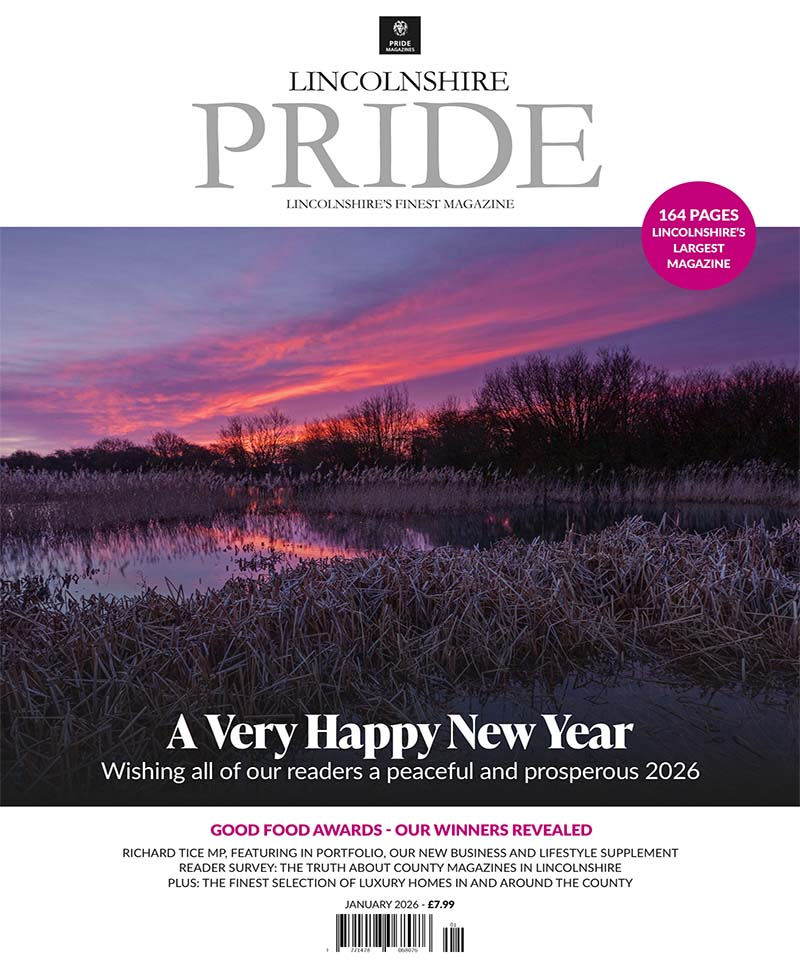
A Different Perspective
This month we’re looking at Lincoln Cathedral in a different way. Think you know the city’s most famous landmark? Well, hopefully, we’ve a few fresh ways for you to look at the building…

One of the Privileges of living right here in Lincolnshire is driving towards the city and gradually seeing the Cathedral hone into view. One of the privileges of being a county magazine editor, though, is being able to see otherwise very well recognised landmarks – like the Cathedral – from a completely unique viewpoint.
Since 2016, the Cathedral has been subject to a programme of extensive restoration to the stonework of its West Front. That restoration is coming to an end as Pride goes to press, and should mean the scaffolding which has been bolted onto the building for too long is finally removed. But the west façade isn’t the only place to see the unusual, quirky and sometimes downright unbelievable features of the building…
The Cathedral’s Clock…
A clock in Lincoln Cathedral was first crafted and installed in the North West tower by John Thwaite in 1775. It was improved and relocated about 60 years later by Benjamin Villiamy. Thwaite could trace his company back to 1610 but the company Thwaites & Reed more properly dates back to 1740 and remains a firm of horological experts today, tending to turret, public and church clocks.
Villiamy, meanwhile, first pioneered the development of the regulator clock – using a pendulum to remain accurate to within about five minutes a week. At the time, Villiamy clocks were regarded as the best of the best, and the horologist was commissioned by King George III to create the ‘official’ regulator clock of the King’s Observatory in Kew which was responsible for establishing an ‘official’ time for London right up to 1884 when the Greenwich Royal Observatory established GMT.
Lincoln Cathedral’s present clock was built by Potts & Sons in 1880 and it included a new feature at the time, Cambridge Chimes – also known as Westminster Quarters – which chime the quarter-hour in the melody with which we’re all now familiar.
In other words, Lincoln Cathedral has always enjoyed the presence of some pretty swish clocks over the years.. ones which we might be inclined to describe as ahead of their time. Electrification has somewhat liberated the Cathedral’s staff from spending 20 minutes each day winding the clock and a further twice weekly winding of the ‘going train,’ or main gears. The clock weighs 4.5 tonnes, and has pendulums up to 82 metres long. Each pendulum is up to 100kg in mass.
The hour hammer, meanwhile, weighs 102kg and strikes upon the Cathedral’s largest bell, Great Tom, which weighs 5.5 tonnes. The bell was recast in 1830 and chimes 40,880 a year. So large was the bell that the tower had to be recast to accommodate it. There are 20 bells in the Cathedral, with those in the West Front responsible for change ringing and those in the central tower ringing to indicate the time.

The Cathedral’s Dimensions…
Lincoln Cathedral is massive. But some other churches in the county are taller. Back in the 14th century it was supposed to be the tallest building in the world, usurping the Great Pyramid of Giza. The latter is a stumpy 138 metres, and Lincoln Cathedral was 160 metres in height.
In 1548 though, a great storm ravaged Lincoln and a gale caused the spires of the building to collapse. The building is now 83 metres in height… that’s a couple of metres taller than Boston Stump (81m), but shorter than Grantham’s St Wulfram’s Church (87m), Westminster Cathedral (87m), Louth’s St James’ Church (89m) and the tallest church in the UK, Salisbury Cathedral, at 123m. Incidentally, the Cathedral is 147 metres long, and its nave 24 metres wide, 24 metres tall.
Take the Floor…
The Cathedral’s internal area is around 5,000m2, and its main construction material is Inferior Oolite Lincolnshire Limestone. The sedimentary material is from a marine bed in warm shallow seas and was created from compressed layers of calcium carbonate.
Purbeck Marble has been used to create the decorative features of the Cathedral like pillars, and the font was one of the early examples of flat pack furniture, created in Tournai marble.
It was transported to the Cathedral and installed in situ. There’s another interesting stone in the floor of the Cathedral’s choir which is inscribed ‘Cantate Hic;’ sing here. ‘The Bone,’ as its known, is shaped like its namesake and represents the most acoustically perfect spot in the entire Cathedral from which to sing.

A Lofty Vantage Point…
Look up and you’ll see the best design details that the Cathedral has to offer. The Cathedral has over 700 windows, 140 with stained glass including the Dean’s Eye and the Bishop’s Eye on the north and south sides of the transept.
In April 2006 a 16-year, £2m restoration of the Dean’s Eye window was completed. To protect the 13th century tracery from the elements, an ‘isothermal’ later of glazing was put in front of the window itself. In other words, some canny double glazing salesman managed to sell some windows to the Cathedral!
Take a look at the ceiling of the nave, too. You’ll notice that when the West Front’s ceiling reaches the portico, it’s out by about a metre… it’s… well, it’s wonky. Incidentally, the ribs in the nave correspond to timber buttresses in the loft and these have a degree of movement; sort of shock absorbers for the stonework. During construction, children were employed to jump up and down on them to test the ‘give’ in the structure. Happily the timber beams provide just enough shock absorption to prevent the vibrations from the bells shaking the tower apart.
And finally… what colour is the Cathedral? Well, stone coloured, surely? Not everywhere. A fire in the 12th century heated the stonework up to about 300°c. At that point, Lincoln limestone turns pink. Most of the stones effected were replaced, but still in places around the West Front, the odd pink stone remains… and what a fetching colour it is!






